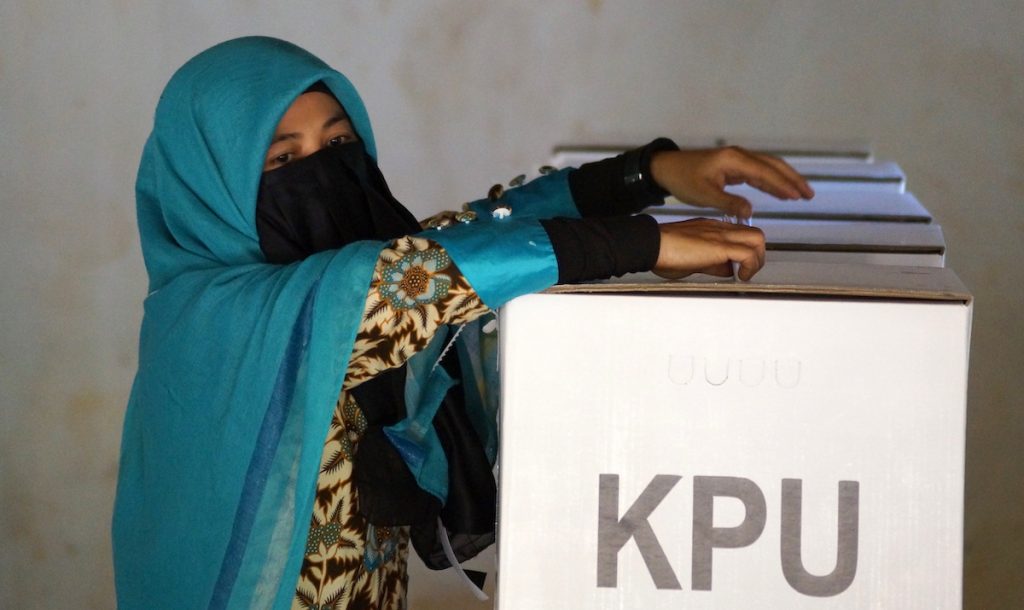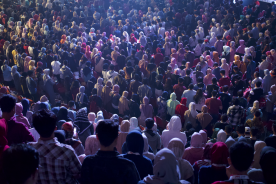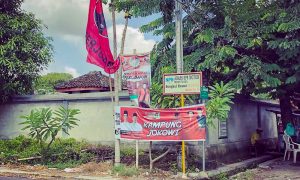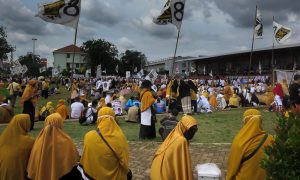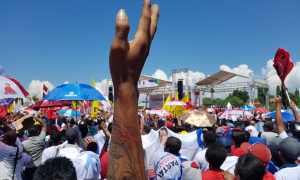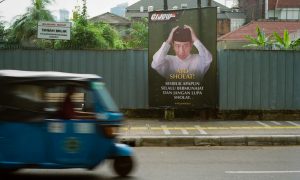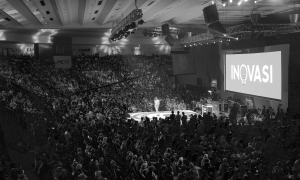When the results of Indonesia’s presidential election became clear last Wednesday evening, they told a story of an electorate even more divided after five years of President Joko Widodo (Jokowi). Jokowi defeated Prabowo Subianto as expected, winning an estimated 54% to 55% of the vote—scarcely improving on the margin by which he defeated Prabowo in 2014.
But it is the distribution of Jokowi’s winning majority in 2019 that best reveals the geographic and socioreligious foundations of Indonesia’s contemporary moment of political polarisation. Early results and quick counts suggest that Jokowi recorded increased votes in the ethnic Javanese-majority heartland provinces of Central Java, Yogyakarta, and East Java, and in “majority-minority” provinces (such as majority-Hindu Bali and majority-Christian North Sulawesi), while his vote fell in most other parts of Indonesia. Majority-Muslim regions beyond Java, from Sumatra in the west to Sulawesi in the east, mostly swung hard against the president.
Peculiar local factors produced some of these trends. In Sumatra, for example, smallholders have experienced hardship over recent years due to moribund world prices for palm oil and other commodities. In Sulawesi, Jokowi’s vote suffered from the fact that he no longer had outgoing Vice President Jusuf Kalla—the most important national politician from that island—as his running mate.
Observers of Indonesian history, however, cannot fail to see that the 2019 results echo deep historical patterns, and point toward underlying social cleavages. During the 1950s, as revealed in the results of the 1955 elections, Indonesian politics were partly organised around a division that grouped syncretic and traditionalist Muslims in Java together with minorities in other islands, against so-called “Outer Islanders”, many of whom were modernist Muslims and supporters of the Masjumi party, the most ardent proponent of Islamist causes at that time. A socio-religious divide coincided with a regional divide, and with the distribution of party support, contributing to the social and political tensions of that era.
This pattern is being reproduced in contemporary Indonesia, at least in part. Conflict over the political and social role of Islam has long been the major organising principle of Indonesia’s political map, but for much of the post-Suharto period this cleavage has been blurred by the pervasive fragmentation that has come to characterise political life during this period, and by the frequency of all-inclusive coalitions that span Indonesia’s socio-religious divides.
In recent years, however, it has sometimes appeared that Indonesians are organising into two political blocs. Especially since the 2016–17 Islamist mobilisations that brought down Basuki Tjahaja Purnama (Ahok), Islamists and their opponents have increasingly faced off—at least when it comes to national politics. This division was on display during the 2019 presidential election: as numerous observers have noted, many of the Islamist groups that opposed Ahok swung behind Prabowo, while groups and parties which uphold pluralism generally backed Jokowi. Indeed, my own and other researchers’ observations of the 2019 campaign point towards the coalescence of a powerful coalition facing down Islamism.
Of course, the picture is complicated, and there are plenty of caveats and exceptions on each side. But it was only necessary to attend campaign events to get a sense of the social gulf separating the two coalitions. For example, at Prabowo’s final large gathering in Jakarta’s Bung Karno Stadium, it was obvious that his campaign was disproportionately garnering support from supporters of a more Islamic Indonesia. The rally had the feeling of a reunion of the so-called 212 movement that brought down Ahok. It was packed with people wearing symbols of Islamist groups such as the Islamic Defenders’ Front (or FPI) and Hizbut Tahrir Indonesia (HTI), and capped off with a video-call from Habib Rizieq Shihab, the rabble-rousing head of FPI, who is in exile in Saudi Arabia. Among the several thousand people I encountered there, I saw only one or two women who were not wearing Islamic headscarves. The final Jokowi rally, by contrast, attracted Indonesians from all walks of life.
In the presidential election results, we see evidence that polarisation is not merely a social media phenomenon, nor an experience of a narrow band of urban Indonesians alone. It also resonates deeply in the Indonesian population and is connected to wide and slow-moving currents in Indonesian history.
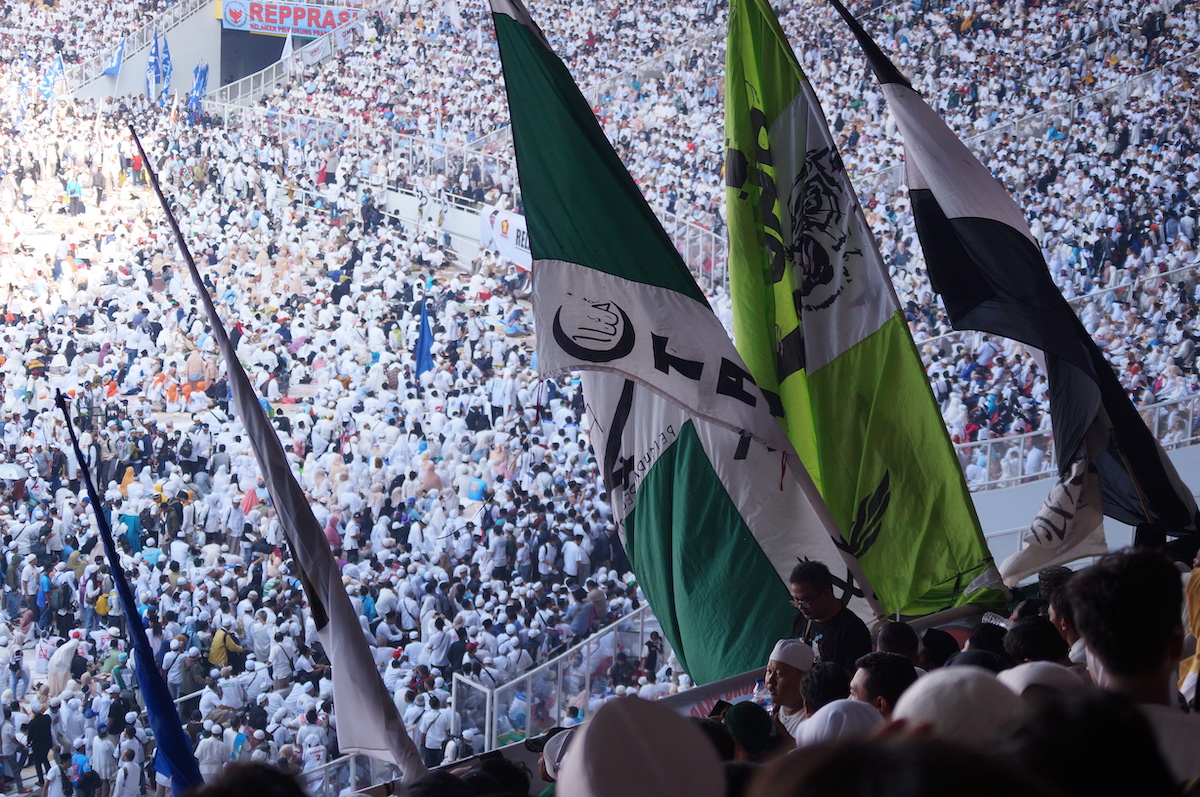
PRABOWO RALLY, BUNG KARNO STADIUM, 7 APRIL 2019 (PHOTO: AUTHOR)
Mobilising for moderation
That Islamists would fall behind Prabowo and attempt to turf out Jokowi in 2019 is not surprising. Such groups supported Prabowo in 2014, and their opposition to Jokowi has been overt ever since. What was more noteworthy in the 2019 election was the hardening of attitudes among the pluralists. Reports from eastern Indonesian provinces such as East Nusa Tenggara and Maluku show that pro-Jokowi campaigners mobilised the vote in such places partly by suggesting that the Prabowo coalition posed a threat to Indonesian pluralism, and to Christians.
Arguably the most important part of this story—and of the 2019 presidential election as a whole—was the campaign to mobilise supporters of the traditionalist Islamic organisation Nahdlatul Ulama (NU) in favour of Jokowi. This sprawling organisation, steeped in the traditionalist Syafi’i school of Islamic learning and rooted in the pesantren, or religious boarding schools, of rural Java, is a massive potential vote base in Indonesia, especially in the heavily populated provinces of East and Central Java. It is also one that leans toward pluralism, seeing that NU leaders are generally (there are exceptions) relatively tolerant of heterodox practices and religious minorities. Though it has a central organisation, NU is best thought of as being a loosely coordinated web of networks built around a shared cultural core, and it rarely has the ability to act in unison during elections.
In the 2014 election, Nahdlatul Ulama was split. Many prominent NU leaders supported Prabowo, and that fact contributed strongly to Prabowo’s strong showing in East Java. In the intervening years, especially since the Ahok affair, NU has been a major beneficiary of Jokowi’s efforts to garner greater Islamic support. Leaders affiliated with NU and the major party associated with it, PKB (the National Awakening Party), have gained numerous government positions, and the NU network has been a major beneficiary of patronage, in the form of educational, development and other programs. Though he was not Jokowi’s initial choice, the president also appointed Ma’ruf Amin, the chair of NU’s governing council, as his running mate.
In this context, NU organised a campaign in favour of Jokowi that was much more unified and focused than any NU electoral effort since 1999 (for an excellent account of the NU campaign see here). The organisation’s national leaders made it clear that their followers should support Jokowi, as did prominent kyai (religious scholars) and NU branch leaders in the provinces (with a few exceptions). The head of NU’s powerful East Java branch, for example, said NU people who did not vote for Jokowi were “goblok” (stupid) . In Central Java, another NU leader suggested that those who did not vote for Jokowi and Amin would be “trampling on the head of NU.” During brief visits to Central and East Java in the weeks leading to the election, I saw signs and billboards proclaiming that it was “wajib” (obligatory) for NU supporters to vote for Jokowi. Everywhere, NU activists and kyai were organising last-minute socialisation events and prayer meetings to ensure that they got out the vote.
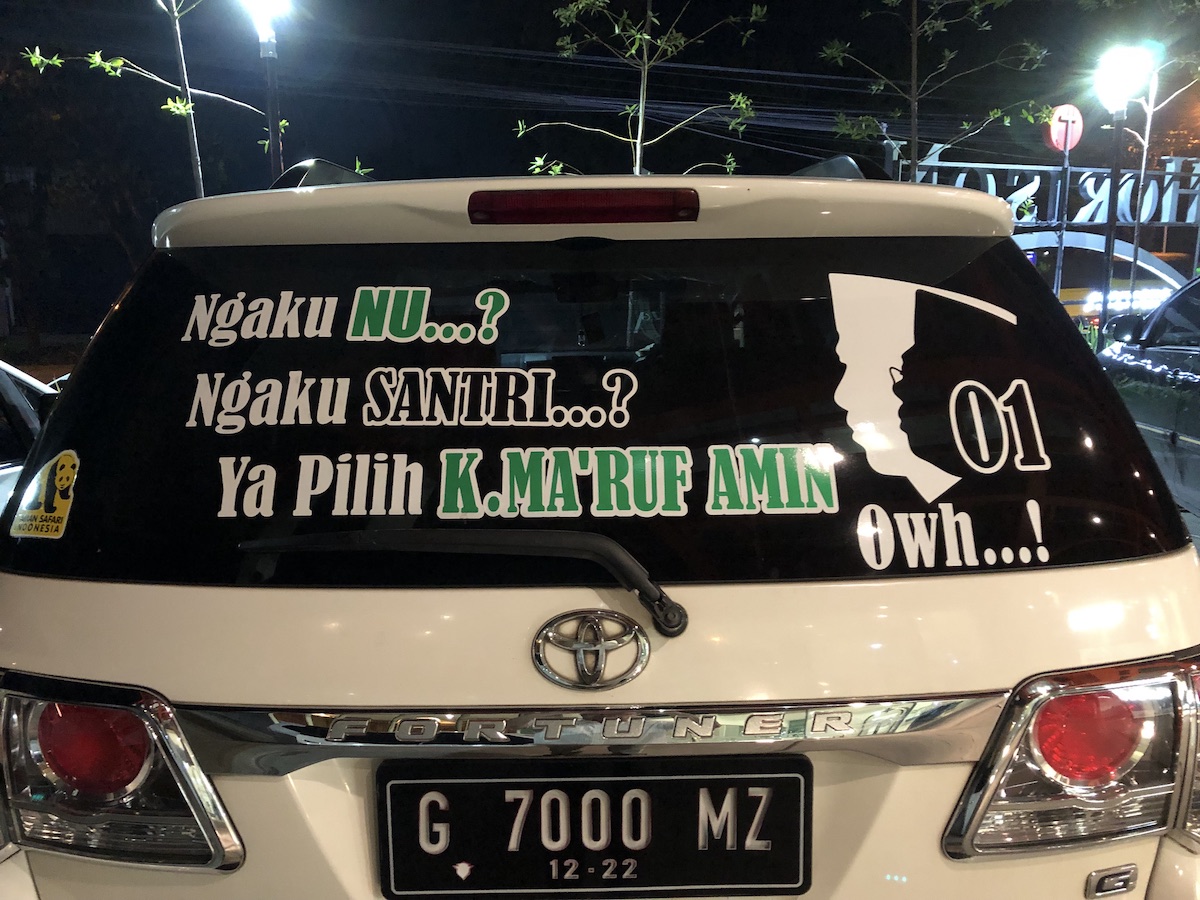
“THINK YOU’RE NU? THINK YOU’RE A SANTRI? CHOOSE KYAI MA’RUF AMIN” (PHOTO: AUTHOR)
This effort paid off. Though we don’t yet have the final results, it is clear that Jokowi recorded strongly increased votes in core NU areas, especially in East and Central Java (as well as in majority-minority provinces). According to an exit poll conducted by Indikator Politik Indonesia, persons claiming affiliation to NU broke in favour of Jokowi 56% to 44%; in 2014 they slightly favoured Prabowo by a margin of 43.1% to 42.2%). As more results become available, it should be feasible to trace this electoral shift in greater detail. At the moment, it seems likely that swings in East and Central Java alone were enough to offset the losses Jokowi experienced in majority-Muslim areas outside Java, and may have been the key to saving his presidency (together, these two provinces provide 61.5 million of the 193 million registered voters).
During my visit to Central and East Java, the thing that struck me most when I spoke to local NU leaders was the language they used to explain why NU was mobilising so strongly in favour of Jokowi. I was expecting to hear defences of engagement in government. NU has a well-established tradition of pragmatism, and previous encounters with NU leaders had prepared me for frank discussions of the material benefits and other advantages NU had derived from cooperation with government.
While my interlocutors acknowledged that such factors had a bearing, they all began with a different set of arguments, saying they were mobilising for Jokowi in order to defend NU’s vision of pluralism and moderation, its traditional religious practices, and to oppose the forces—which they variously described as the “Islamic right” (Islam kanan), “Islamic hardliners” (Islam garis keras) and supporters of a universal caliphate (khilafah)—they saw as mobilising behind Prabowo. In short, they framed their mobilisation in ideological rather than pragmatic or strategic terms, and as part of a wider struggle to defend the Pancasila (Indonesia’s state philosophy, which recognises the centrality of religion in Indonesia’s political life, but does so in pluralistic form) and NKRI (the Negara Kesatuan Republic Indonesia or Unitary State of the Republic of Indonesia—a term for describing Indonesia that has become a catchphrase used to highlight threats to Indonesian unity allegedly posed by separatists, Islamists or other subversive groups). NU leaders were just as adamant about who and what they were opposing as they were about what they were defending, and they spoke as if NU and Indonesia were facing an existential threat.
It might be objected that such ideological arguments are self-serving. Obviously, they are. But in my view that is the least remarkable part of this story. Instead, it was the consistency of the ideological message I found most noteworthy. Among the dozen or so NU informants I spoke to, the message was uniform, suggesting a concerted effort had been made through NU structures and networks to promote, popularise and standardise this vision. Indeed, it has been obvious that an ideological campaign has been underway in the NU community for several years now—at least since the formalisation of efforts to promote “Islam Nusantara” (Archipelagic Islam) was launched at the 2015 NU congress. Many of the NU leaders I spoke to said they had become increasingly conscious of the threats posed by preaching by salafi and other hard-line groups in NU communities, and by the activities of these groups’ charitable and educational institutions, since the rise of the anti-Ahok movement.
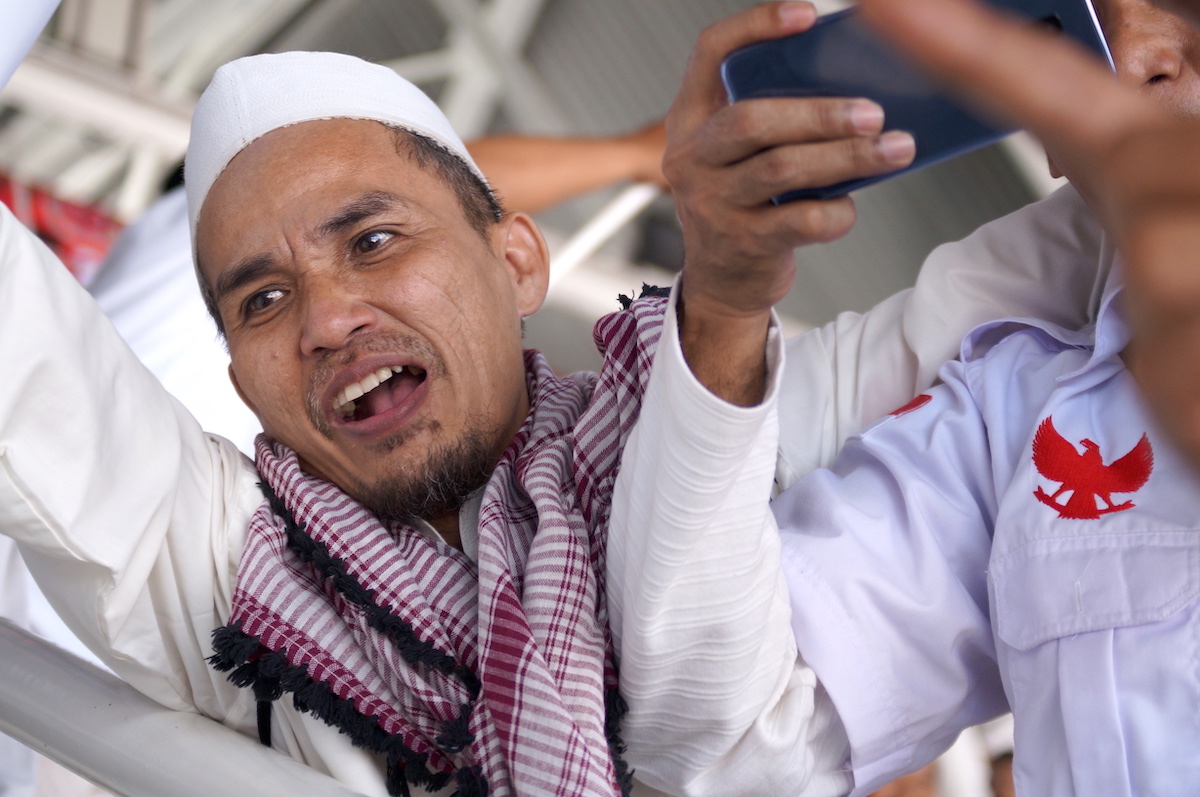
PRABOWO SUPPORTERS AT 7 APRIL STADIUM RALLY, JAKARTA (PHOTO: AUTHOR)
The trend apparent in NU is significant in that it reflects a wider hardening of views among pluralists. Over the last couple of decades, it has sometimes seemed as if the social and political tides in Indonesia were flowing inexorably in favour of Islamism. Politically, the tendency towards all-inclusive coalitions provided Islamist groups leeway to participate in power-sharing arrangements and establish footholds in the government. Mainstream politicians’ desires to appeal to median voters and placate powerful interest groups gave them incentives to promote conservative Islamic causes. Slow-moving trends of urbanisation and economic growth, meanwhile, were generating increasingly puritanical strains of Islamic thought and practice among the middle classes of Indonesia’s cities and towns, enabling Islamists to expand their influence through universities, the civil service, and in the private sector. Pluralists were hampered in their attempts to resist these trends by the fact that religion in general, and religious authority in particular, are both highly legitimate in Indonesia. When someone openly resists Islamist influence, they run the risk of being accused of insulting religion itself (Ahok fell precisely into this trap).
But the pluralist worm may finally have turned. The pluralists have found their rallying cry (“defend NKRI”) and their Other (handily, though frequently misleadingly, summed up as supporters of the “caliphate”). And they have begun to mobilise, and not just through elections. Jokowi’s government has become increasingly willing over recent years to resort to authoritarian tactics against its critics, including Islamists (for example, it banned Hizbut Tahrir Indonesia), a phenomenon Marcus Mietzner has described as “fighting illiberalism with illiberalism.” In recent months, there has been accumulating, albeit largely anecdotal, evidence of something akin to a purge of supporters of groups like Hizbut Tahrir and even PKS (the Prosperous Justice Party, Indonesia’s most important—and legal—Islamist party) beginning in some higher education institutions, government departments, state enterprises, and even in parts of the private sector.
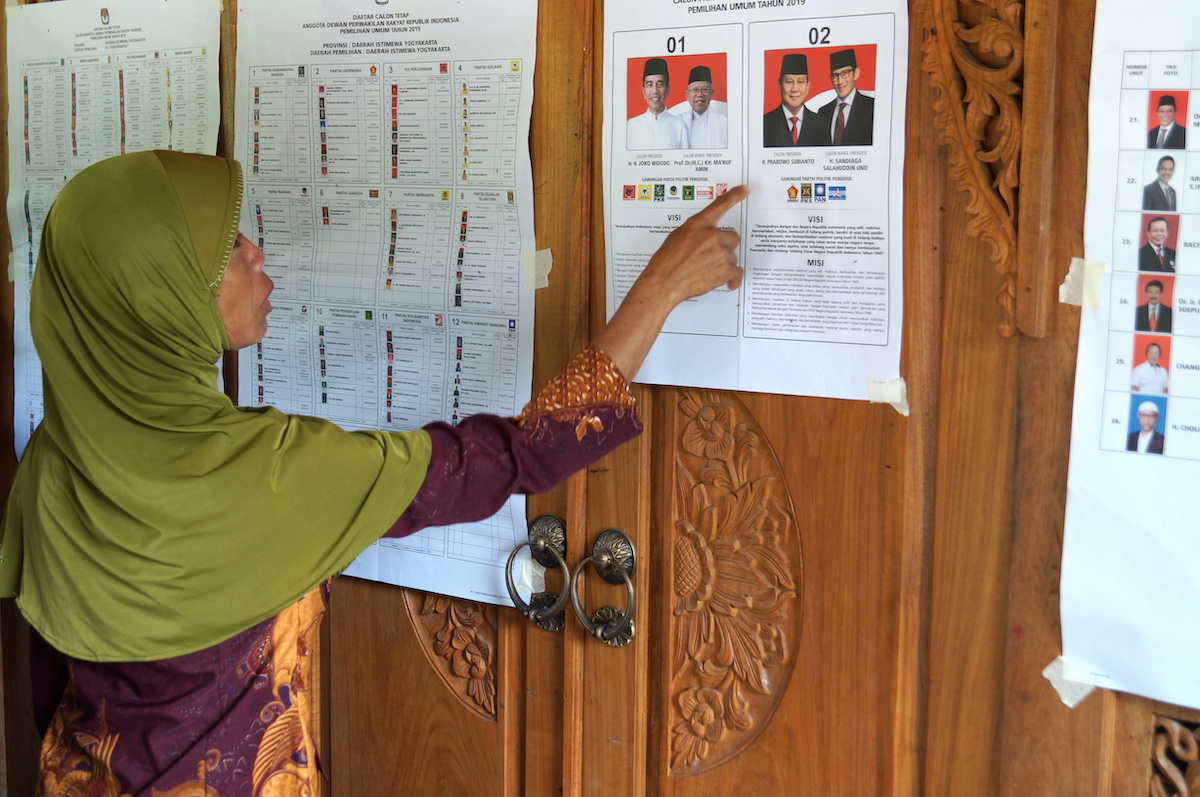
A VOTER AT A VOTING BOOTH, 17 APRIL (PHOTO: AUTHOR)
Limits to polarisation
Before concluding, two very big caveats are in order. One is that the ideological game is being played out at two levels, involving co-optation as well as contestation. As numerous observers have pointed out, ever since the anti-Ahok mobilisations, Jokowi has made many concessions to Islamic groups—with NU being only the most obvious beneficiary. It is possible that political opposition to Islamists will be compatible over coming years with continuation of a slow drift toward conservative religious cultural and social policies. Moreover, the slow-moving social processes turning Indonesia’s urban centres into engines of Islamisation are still in train. Social pluralism might still slowly erode as political pluralism triumphs.
The second caveat is that there are still serious doubts about the extent to which the political polarisation sketched in this article penetrates to the grassroots of society and even to core institutions of political life, rather than being an epiphenomenon that coheres fleetingly during presidential elections and other major national events, thereafter to fade once more.
The party system is still fragmented rather than polarised, with parties differentiated on the Islamist–pluralist spectrum, but not much on other issues. When parties form electoral coalitions in provincial and district contests, the cleavages on display in this year’s presidential election matter little, with all-inclusive coalitions remaining the order of the day. Yet it is difficult to imagine political polarisation being sustained in a democracy without it being meaningfully expressed through the party system.
Meanwhile, most of the pro-Prabowo legislative candidates I encountered during my time in East and Central Java saw little benefit in promoting Prabowo’s candidacy while running their own campaigns. A campaigner for a PAN (National Mandate Party) candidate running in the rural hinterland of Yogyakarta, for example, said he only promoted Prabowo’s presidential bid when campaigning among the relatively small group of supporters of Muhammadiyah (Indonesia’s largest modernist Islamic organisation) in his constituency. To win the support of NU and abangan (syncretic) communities, he provided them with small-scale infrastructure and village improvement projects and, when necessary, with money. In these communities he did not talk about Prabowo at all. “That would not be realistic”, he explained.
A PKS candidate running in Surabaya, the capital of East Java, did something similar. Entering communities as an ustadzah (female preacher) and supporter of micro-enterprises, she would first get a sense of the sympathies of the communities where she was campaigning when it came time to take the obligatory group photos after an event: when posing, she would hold up her thumb and forefinger—the symbol used by supporters of the Prabowo camp to signify their candidate’s number 2 position on the ballot. If people followed suit, she would then talk about the Prabowo campaign. If they did not respond, or held up one finger (Jokowi’s symbol), she kept away from the topic altogether.
How ‘moderate’ are Indonesian Muslims?
The numbers on how Indonesia stacks up in comparison to other Muslim-majority countries.
What sense can we make of these contradictory trends? On the one hand, it seems clear that Indonesian politics has definitively entered a new phase. Over the last five years, the country has—at least in part—moved beyond the politics that shaped the immediate post-Suharto period, when pragmatism, patronage, and accommodation ruled unchallenged. Ideological mobilisation, polarisation, online hate campaigns, and all the rest are becoming increasingly influential in national politics.
On the other hand, this new phase is marked heavily by what has come before. The new trends are emerging in a structural context still heavily weighted toward the pursuit of patronage and accommodation. Even as Prabowo fires up his core supporters with fanciful claims that he was the true winner of the presidential race, it is likely that many of those same supporters are preparing to reposition themselves for a mutually-beneficial peace with a re-elected Jokowi. Yet further rounds of polarising politics—not least in the national elections in five years’ time—seem equally possible. A new political order is emerging within the structure of the old, posing challenges to analysts trying to map and understand contradictory trends.
 Facebook
Facebook  Twitter
Twitter  Soundcloud
Soundcloud  Youtube
Youtube  Rss
Rss 